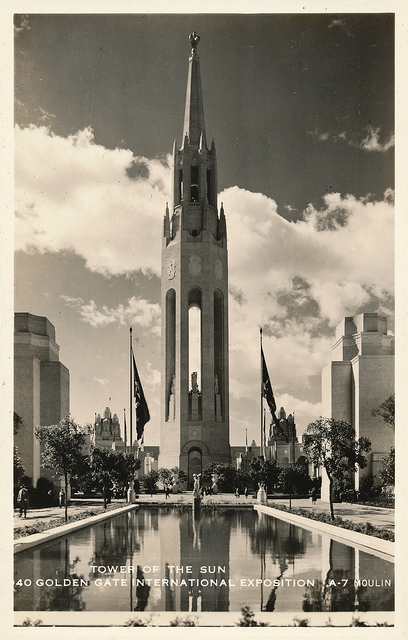The fact that Seattle's Space Needle had reached its half-century mark prompted me to write this post. It also got me to thinking about world's fairs and structures that came to symbolize them, intentionally or not.
If you are interested in delving into those expositions, Wikipedia kindly provides two useful listings. Here is a list of fairs that includes important structures and other relevant items associated with them. And here is a list of BIE sanctioned expositions, the BIE being an international fair-sanctioning organization founded in the 1920s. Not all major fairs since them have had BIE approval, the most important instance being the New York World's Fair of 1964-65.
The idea of a structure intended to symbolize a fair is a fairly recent development, as these things go. First, consider first great fair in London in 1851. Joseph Paxton designed an iron and glass structure called the Crystal Palace that served as the fair's symbol by default: it was the fair's only structure.
For a while other fairs followed suit, but eventually became collections of pavilions, each focusing on a different country, industry or other theme. Architecturally, there might be a focus building such as the 1893 Chicago fair's Administration Building with its large dome situated at one end of a rectangular reflecting pool. Although that building was prominent, I'm not sure how symbolic it was given that the fair's overall appearance was a kind of mega-symbol.
Explicit symbol structures didn't come into play at top-level fairs until the end of the 1930s. Since then, other fairs have used them (or not) to varying degree of success. Let's take a look at the famous ones, plus a wannabe:
Gallery
Eiffel Tower (1889) in 1937
The Eiffel tower was erected for a 1889 exposition to mixed reviews. But it proved so popular that it now is the symbol for Paris itself. The photo above was taken at the Exposition Internationale des Arts et Techniques dans la Vie Moderne of 1937, best known to art junkies as the place Picasso's Guernica was first displayed. The Eiffel Tower probably wasn't the symbol of this fair: it just happened to be on the Champ-de-Mars, the largest chunk of unobstructed Paris land available for such events. Otherwise, the two dominant structures besides the tower are seen framing it in the photo. At the left is National Socialist Germany's pavilion and to the right is the pavilion of the Soviet Union, ideological antagonists until the countries signed a pact two years later that signaled the start of World War 2.
Palace of the Fine Arts - San Francisco, 1915
I'm not up to speed on the Panama Pacific International Exposition, so I'm not sure if the Palace of the Fine Arts was considered the fair's symbol at the time. But it soon came to be so loved by the public that it avoided destruction once the fair ended. It still stands today, having gone through at least one major restoration.
Trylon and Perisphere - New York, 1939
Now we come to structures intended to be symbolic from the outset. The Trylon, a three-side pyramid, stood 610 feet (190 meters) tall and had no function other than being somehow symbolic of the future. Its mate, the Perisphere, contained an exhibit.
Tower of the Sun - San Francisco Bay, 1939
The Golden Gate International Exposition was held on an island dredged from the bottom of San Francisco Bay that was intended to be used as an airport after the fair closed. The 400-foot tower was the fair's symbol. It seems that all such symbol-structures attract both fans and detractors. This book offers the following observation (p. 82): "As for the Tower of the Sun, the 400-foot campanile sticking up from the low horizon, hardly anyone could tolerate it." The anyones quoted included columnist Herb Caen and sculptors Beniamino Buffano and Ralph Stackpole. Contrarian me? I think it was just swell.
Unisphere - New York, 1964
Sitting where the Trylon and Perisphere once stood, the Unisphere arrived to symbolize New York's fair of the mid-1960s. I've always thought that the Unisphere was a triumph of cliché and imagination-failure. Regrettably, it still stands.
Atomium - Brussels, 1958
The Exposition Universelle et venti Internationale de Bruxelles had the Atomium as its symbolic centerpiece. It is supposed to represent a scaled-up atom, and people can actually climb through the thing. It, too, is still with us for some inexplicable reason. (Unlike the Unisphere's failing, I find the Atomium simply silly.)
Space Needle - Seattle, 1962
I end this rogue's gallery with the beloved Space Needle from Seattle's Century 21 fair. It can seem a little awkward if you view it from the wrong angle, but it's distinctive in a graceful way. Or, to put it another way, it coulda been a lot, lot worse.

















































